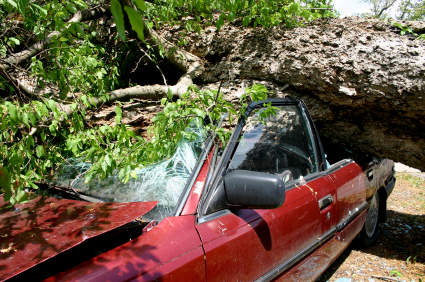 When a spring or summertime storm or tornado strikes, flying tree limbs and related debris can be a significant cause of damage, according to claims data from Nationawide Financial.
When a spring or summertime storm or tornado strikes, flying tree limbs and related debris can be a significant cause of damage, according to claims data from Nationawide Financial.
Fortunatley there are steps homeowners can take to reduce the chance of damage to their house or vehicles.
“Tornadoes happen any time of the day and year,” said Pete Lore, Nationwide’s associate vice president of claims, said in a statement. “Don’t wait until a storm is on the horizon. You can do simple things right now to try to mitigate damage to your home or car, saving you a headache and mess later.”
Nationwide Insurance reviewed claims data related to tornadoes from 2008 to 2012 and found that, other than a direct hit from a tornado, tree debris or trees fallen by wind generally cause the majority of the tornado-related damage to autos and homes. The danger zone for homes and autos in a tornado is as much as two miles from the eye of the storm.
The most common insurance claims for automobiles are fallen tree branches. Larger losses are from broken windows and windshields, which allow rain water into the automobile, resulting in more damage. The historical average auto claim for tornado damage is $4,000.
A majority of the insurance claims for homes come from damage to roofs, siding and personal property. Larger losses are mainly due to the home being in the direct path of the tornado. Other large losses come from fallen trees and their branches, which can punch holes in the roof or walls, allowing large amounts of rain water into the home. The historical average home claim for tornado damage is $24,000.
While only two percent of the tornadoes achieve the most violent and damaging classifications, 25 percent of tornadoes have proved to be powerful enough to cause 90 percent of the damage and 66 percent of deaths in the United States, according the Insurance Institute of Building and Home Safety.
According to the National Weather Services’ Storm Prediction Center, there were 1,119 tornadoes in 2012. Kansas had the most with 145, followed by Texas, Alabama, Mississippi and Kentucky. There have been 103 tornadoes in 2013 as of Feb. 19.
Reducing the portential for tornado damage
Long before the storm:
• Replace landscaping materials such as gravel and rock with mulch such as shredded bark.
• Keep trees and shrubbery trimmed, paying particular attention to weak branches that could fall on a home or a neighbor’s.
• Make sure that both the roof covering and the sheathing it attaches to will resist high winds.
• Make certain that doors have at least three hinges and a deadbolt security lock with a bolt at least 1 inch long.
• Install permanent wood or metal stiffeners on the garage door, or contact the door manufacturer for information on temporary supports that can be attached and removed easily when severe weather threatens.
• Install impact-resistant window systems.
Right before the storm:
• If weather forecasters are predicting severe weather in the coming days, remove anything from the yard that could become flying debris.
• While under a tornado watch, move the car into a garage or away from any trees. Do not attempt to do this if conditions are unsafe or if a tornado warning is issued.











